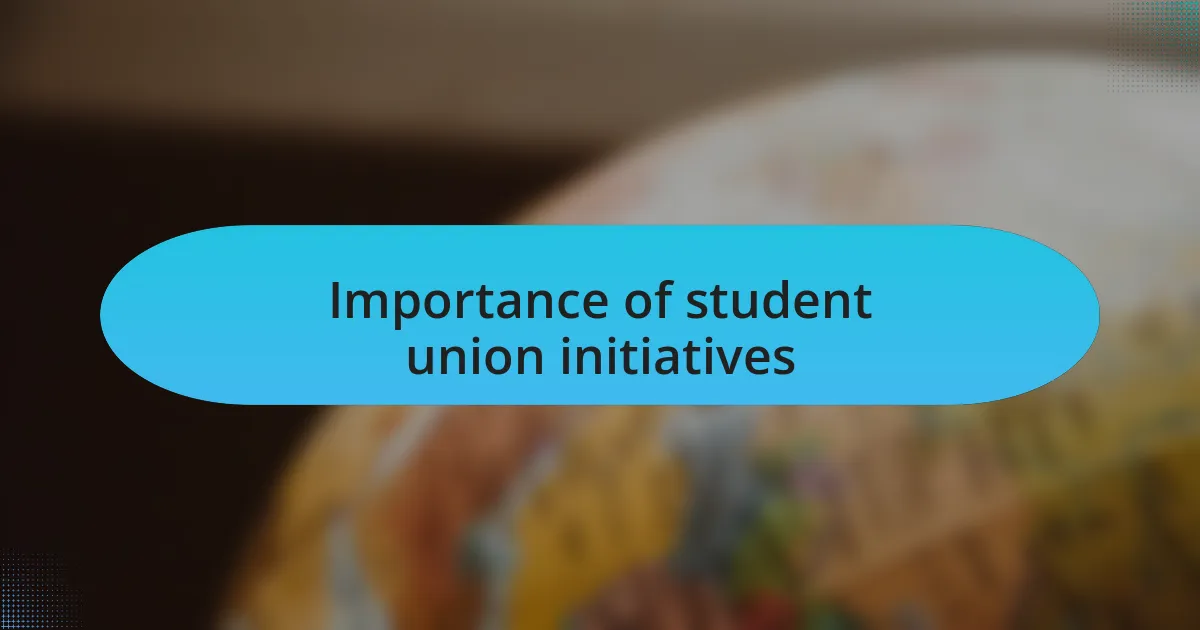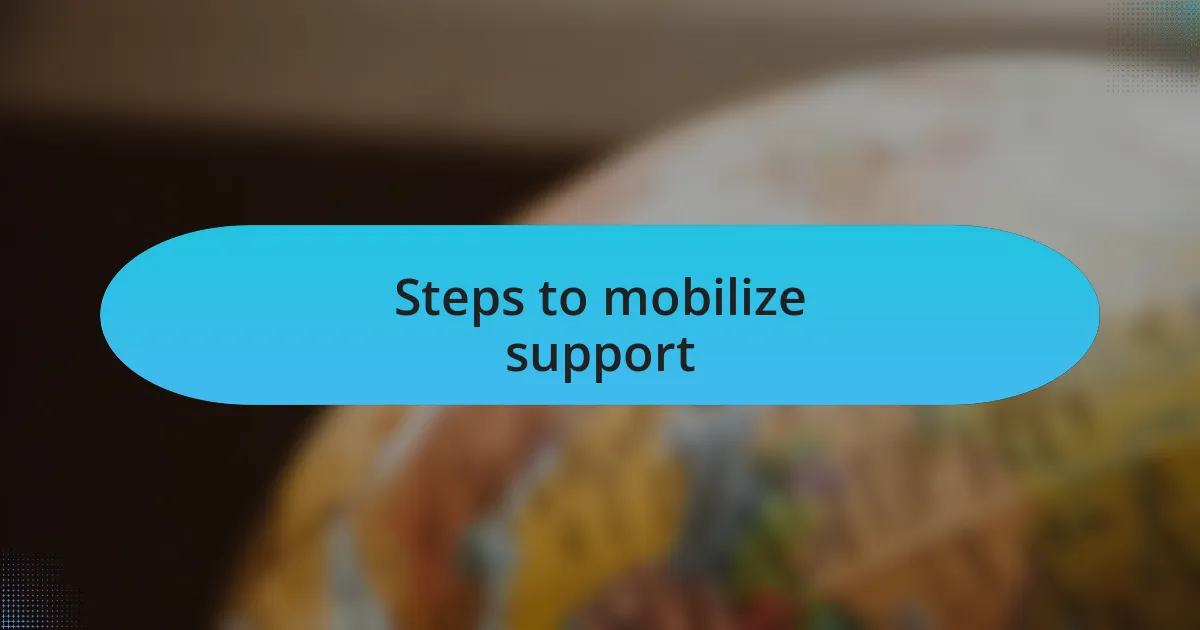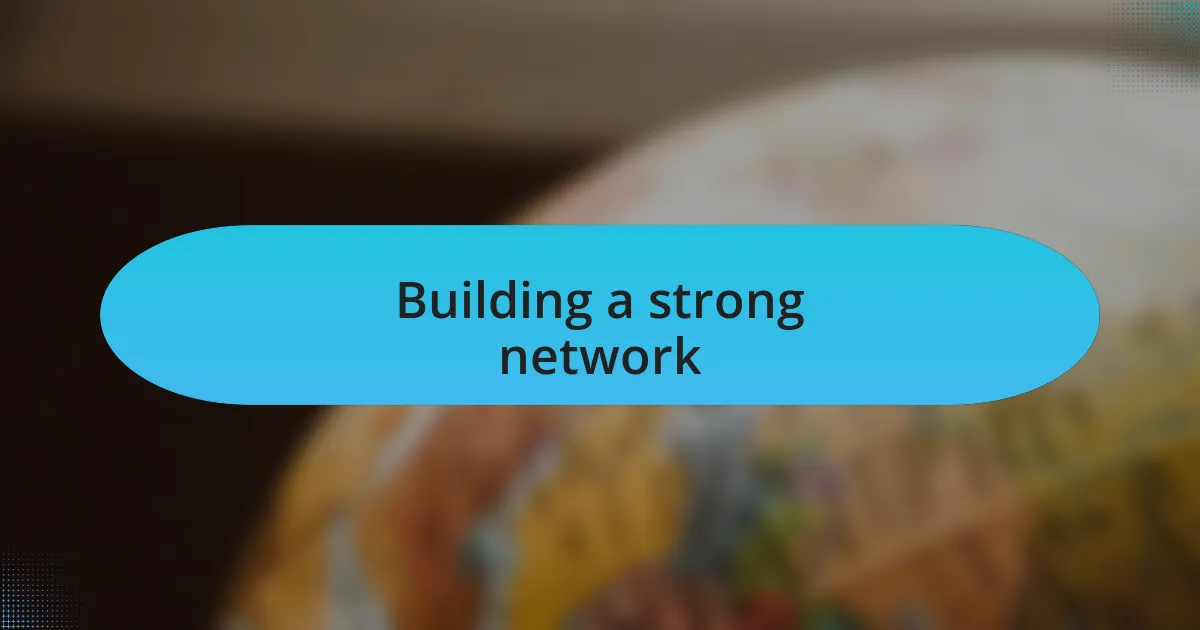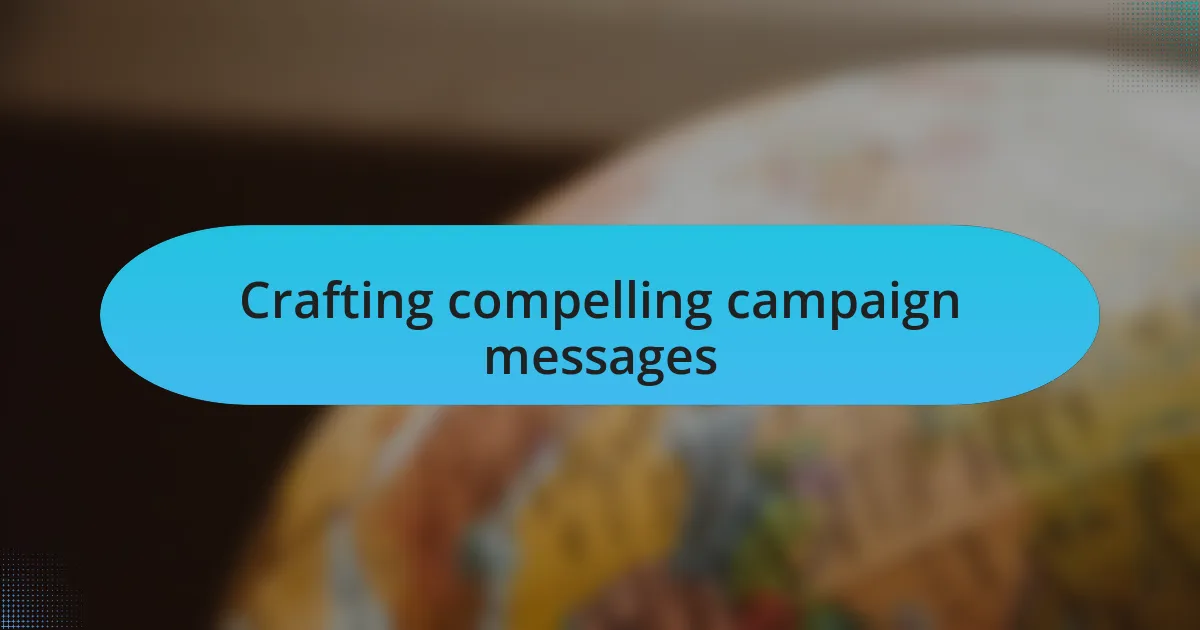Key takeaways:
- Student unions play a crucial role in fostering community, leadership, advocacy, and cultural expression among students.
- Initiatives from student unions improve campus life, such as mental health awareness and library services, while also developing essential skills for future careers.
- Effective support mobilization involves understanding the audience, building partnerships, and engaging through social media and events.
- Authenticity, clarity, and actionable calls to action are vital when crafting campaign messages to inspire collective involvement.

Understanding university student unions
When I think about university student unions, I remember my own experience stepping into the bustling environment during my first year. It was a place buzzing with activity, where students gathered not just to socialize, but to be part of something bigger than themselves. Does that sense of community resonate with you?
Student unions serve as a fundamental hub on campus, providing students with opportunities to engage in leadership, advocacy, and cultural expression. I recall joining a club during my second semester that was entirely focused on international cultures. The friendships I forged and the experiences I gained reshaped my outlook on diversity and inclusion, proving just how vital these organizations are to personal development.
Moreover, they act as a bridge between students and university administration, voicing concerns and advocating for student needs. Reflecting on my own initiatives, I often wondered: How many issues go unaddressed without the support of our unions? Understanding this role emphasizes why student unions are not merely supplementary; they are integral to the overall well-being and empowerment of the student body.

Importance of student union initiatives
Student union initiatives play a crucial role in fostering a sense of belonging among students. I remember when my union organized an awareness campaign about mental health resources on campus. It struck me how many students were unaware of the support available to them, and seeing my peers engage in this initiative made me realize the power of awareness—it truly can change lives. Have you ever felt lost in the shuffle of a large university? Initiatives like these provide clarity and direction, showing students they are not alone.
Additionally, union initiatives often lead to tangible improvements in the campus environment. Take, for example, the time we campaigned for extended library hours during exam weeks. The late-night study sessions I shared with friends were far more productive because we had a quiet space to focus. This experience not only made my academic life easier but also demonstrated how collective action can lead to impactful or even unexpected outcomes. Isn’t it empowering to think that our voices can create change?
Finally, these initiatives also cultivate essential skills that will benefit students long after they graduate. I distinctly recall organizing a fundraiser; it taught me about teamwork, budgeting, and communication. Looking back, I realize that these experiences shaped my professional identity and prepared me for the workforce. By participating in student union activities, aren’t we not just shaping our current environment but also building our future selves?

Steps to mobilize support
To mobilize support effectively, start by identifying your audience and their interests. I recall a time when we wanted to initiate a sustainability project on campus. By surveying students, we learned they were most passionate about reducing plastic usage, which allowed us to tailor our message. Have you considered how understanding your audience can enhance your initiatives?
Next, build partnerships with other organizations or departments. Collaborating with the environmental club was instrumental for us; they had established connections and resources. This teamwork not only amplified our reach but also fostered a sense of community. Isn’t it fascinating how blending efforts can lead to greater camaraderie and results?
Lastly, utilize social media and campus events to spread the word. I remember launching our campaign through a vibrant kickoff event filled with engaging activities and live demonstrations. The energy was contagious and sparked conversations that kept the momentum going on social platforms. How often do you find that genuine engagement leads to organic support? It’s a simple but powerful way to garner enthusiasm and participation from students!

Building a strong network
One of the most rewarding aspects of building a strong network is the sense of belonging it creates. I vividly remember attending my first student union meeting; the atmosphere was electric, filled with diverse voices coming together for a common goal. It struck me how easy it was to connect with others who shared my passions, forging relationships that extended beyond mere acquaintances. Have you ever experienced that moment when a simple conversation turns into a partnership that can change everything?
Moreover, leveraging alumni connections can significantly enhance your network. I once reached out to a former student union president who now worked in a related field. The insights and guidance they provided were invaluable, not only for my initiative but also for expanding our university’s reach into the local community. Isn’t it remarkable how these established connections can open doors you never even knew existed?
Finally, being proactive in engaging with underrepresented groups amplifies the strength of your network. When we organized focus groups that included a mix of voices—from different cultural backgrounds to students with varying abilities—it enriched our discussions and outcomes. I often think about how crucial it is to ensure everyone feels heard. Wouldn’t you agree that the best ideas often come from the most diverse perspectives? Building a strong network means acknowledging and embracing these differences.

Engaging fellow students effectively
Engaging fellow students effectively starts with genuine conversations. I recall sitting in a campus café, brainstorming with a group of friends about ways to rally more support for our initiatives. It was amazing how just sharing a few laughs created an environment where everyone felt comfortable voicing their ideas. Have you noticed that when we let our guard down, more innovative thoughts emerge?
To truly engage, using social media can be a game-changer. I remember posting an informal poll about what events my peers wanted and was surprised by the diverse responses. It reinforced my belief that when students feel their opinions are valued, their involvement grows exponentially. Isn’t it interesting how a simple online interaction can lead to real-world participation and excitement?
Lastly, meeting students where they are can foster stronger connections. I once organized a casual open mic event, inviting anyone to share their thoughts or talents, and the turnout was incredible. It wasn’t just about performance; it was about building a community. Have you ever tried something similar? There’s something powerful about creating spaces where everyone can express themselves, making engagement feel more like a natural extension of their daily lives.

Crafting compelling campaign messages
When crafting campaign messages, I find that authenticity resonates most deeply. One of my most successful campaigns began with a simple yet heartfelt message about why the initiative mattered to me personally. Sharing my own experience connected me with others on a level that statistics and dry facts never could. Have you experienced that moment when your story finds echoes in others’ lives? It’s a reminder that our narratives can bridge gaps and inspire solidarity.
The clarity of your message is paramount. I recall a time when I led an awareness campaign on mental health; the initial attempt was muddled with jargon and complexities. After simplifying our language and focusing on relatable stories instead, the response was overwhelmingly positive. It’s fascinating how stripping away the clutter makes a message not only more digestible but also more impactful. Have you ever noticed how a clear message just seems to stick with you?
Lastly, call to action plays a crucial role in mobilizing support. During a recent initiative about sustainability on campus, I wrote a direct message urging students to make “one small change” in their daily routines. The simplicity of that request sparked a movement. It’s incredible how inviting someone to take immediate, manageable action can galvanize a group. What do you think is more motivating: grand ambitions or small, tangible steps that we can accomplish together?

Reflecting on successful strategies
Reflecting on successful strategies, I’ve often found that collaboration is a cornerstone of effective mobilization. One initiative I spearheaded on campus revolved around community service, where I engaged multiple student organizations. It was a revelation to see how sharing resources and ideas created a powerful synergy, resulting in a larger turnout than any one group could have achieved alone. Have you ever noticed how teamwork can turn an ordinary idea into something extraordinary?
Additionally, I believe that building relationships with stakeholders is vital. When I worked with local businesses for a fundraising event, I made it a point to understand their motivations and goals. This approach allowed us to create mutually beneficial partnerships that not only brought in funds but also fostered a sense of community engagement. Isn’t it fascinating how understanding someone else’s perspective can open doors to unexpected opportunities?
Lastly, I’ve learned that celebrating small wins can sustain momentum. During a recent initiative focused on diversity, we marked milestones, no matter how small, which kept spirits high and participants motivated. Each recognition felt like a shared victory, reinforcing our collective commitment. Have you ever experienced how acknowledging progress can energize a group and inspire further action?